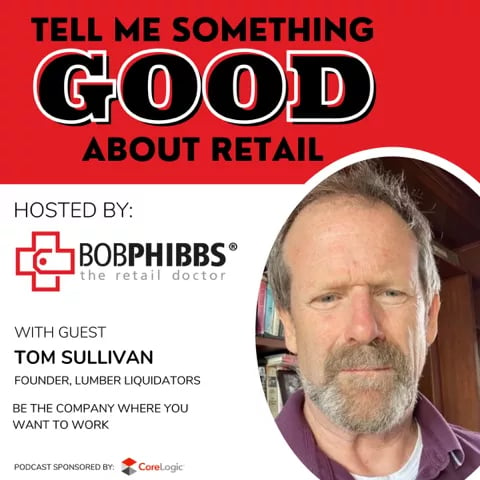Retail Podcast 603: Tom Sullivan Be The Company Where You Want To Work

Bob Phibbs interviewed Tom Sullivan, founder of Lumber Liquidators, about going public, about his first steps at founding the largest specialty flooring company in the nation, and what bugs him - and Bob - about brick-and-mortar stores.
.webp?width=178&height=178&name=Sullivan%20(1).webp)
Tell me something good about retail
Tom Sullivan: Be The Company Where You Want To Work
Bob: Today, I get the opportunity to talk with Tom Sullivan, the founder of Lumber Liquidators, the owner of Gracious Home, and the founder of Cabinets to Go, and a serial entrepreneur. Welcome, Tom.
Tom: Thank you, Bob. Thanks for having me.
Bob: You bet. I have to start out and ask you...You started out at a young age, being an entrepreneur, and I understand it has something to do with bicycle tricks. Is that true?
Tom: Yes. In fact, I don’t know how old I was, but 12 or so, maybe younger, built a couple of ramps. I used to like Evil Knievel, watching Evil Knievel, so I tried to be Evil Knievel on a bicycle. And I built some ramps and had a bicycle, and people paid 50 cents to watch to see if I could make it from one ramp to the other in my driveway.
Bob: And did you usually make it, or was it just take the money and run? How did it work?
Tom: Well, even if I didn’t make it, I’d still get the money. No, but I usually made it.
Bob: Nice.
So, I love the story of how you started Lumber Liquidators and starting in retail when you had your own construction company up in Boston. Can you let our listeners know how that all worked out?
Tom: Yes, so I had tried many things, starting with probably before the bicycle jump, different things and different businesses, different ideas. But I always had done remodeling stuff like, in high school, painted houses for people, landscaping, shoveled snow when I was younger, cut grass, all that, sell Christmas cards door to door. So for some reason, I was always interested in that stuff. So between contracts, I had come up with an idea to try a business and work, but always learned something. So, I started storing lumber. I was building a lot of decks, sun decks in the Boston area, and started storing lumber at a place called Cohenno Trucking and Warehouse out in Stoughton, Mass. And they were a trucking company, but they specialized in lumber. They didn’t own any of the lumber, but people like Georgia Pacific or whoever would ship product there. When they sold it, they would pay Cohenno to ship a lip to different lumber companies.
So, in storing my lumber there, I started seeing some leftover stuff that wasn’t bad, it just looked...the outside of it was weathered, the packaging was a little ratty, but the product itself was good. So found out who owned these different products and called them to see if they wanted to sell it at a discount. So, I made a few deals, and then on a Saturday, put an ad in The Boston Globe and other places and had a Saturday sale. It was actually Friday, Saturday, Sunday. So, the first time I did it, there was all these pickup trucks driving around Cohenno Trucking trying to find out where this lumber was, so they weren’t too happy. So we made a deal to move it out to a space closer to the street.
But it was fun, and it was a good business, so I kept trying to find deals and different type of building materials deals and to send out a fax to lumberyards and suppliers saying we buy excess material, or whatever, and then also built up a list of people who needed different products for builders and people who used wood in manufacturing. So I’d have another email list that would go out and say, “We have these 10 items.” So, during the week, I would do that stuff and then on the weekends do the open-to-the-public kind of thing. It was just an outdoor shed, so it was kind of always open.
Bob: And I think that original first store is still there and looks pretty much like a shed, isn’t it?
Tom: Well, this was literally in the back of a trucking company in a warehouse under just a cantilever roof. So, the first Lumber Liquidator store, that was a year or two later, and that was extremely fancy, even though that didn’t have running water or bathrooms.
Bob: Well, I love the way you just found the opportunity. And when you were starting out, I think you told me that you had had different phone numbers, wasn’t it, that people would call, and that’s how you knew where to locate your stores, by the amount of interest?
Tom: Oh, yes. So getting to Lumber Liquidators, from Cohenno, there was a place in there that sold hardwood flooring, and they had a deal on flooring. So I bought that and it was a much better business. Instead of having people sift through 200 two-by-fours to take 10 two-by-fours, people would come in and buy 500 to 1,000 square feet of flooring. So that’s how I started the Lumber Liquidators. Then we opened the first store in West Roxbury, store one. It was an old metal building behind a retail shop on Route 1 in West Roxbury, wedged between the Charles River and this other retail building. So we started that. It started off a little slower, but it was in the middle of January...or January 5th, in ‘96.
And it started off a little slower, but it was built up to be a much better business, just specializing in flooring and learning that business and kind of doing the same thing. Called flooring mills, find out what they had for excess stuff, and have sales. But then when I was thinking of a second store, we put...at that time, it was just classified ads. The internet was just barely starting. So I was thinking in Hartford, Manchester, New Hampshire, or New York and put an ad in each of those papers, and the phone rang off the hook from Hartford, so we went to Hartford for the second store.
Bob: And in case you didn’t know, that ended up becoming the largest hardwood flooring company in the nation, right?
Tom: Eventually, yes. And it was funny, it was probably a year or two after I started when I had three or four stores, and then I kind of realized this was what I was trying...I had thought of the idea, not necessarily hardwood flooring, but just to have these retail warehouse-type stores around the country. And it was always in the back of my mind, but I didn’t know what the product was, and then when I found the product, it was kind of built into that, what I was thinking of.
Bob: And you took it public. Was that always a dream of yours, or was that just opportunity?
Tom: Don’t remind me.
Bob: Well, you’ve definitely had some ups and downs there, I know that.
Tom: No, it was I wouldn’t say a dream to go public. It was always an idea. And while I was talking about that, everyone said, “Why are you doing that? You’re going to hate it.” And I said, “Well, what could go wrong? We just sell hardwood flooring.” Well, there are two things with that. One, we just look like the rinky-dink operation with little warehouse-type stores and back of industrial parks and dead-end roads and small showroom and store. But once people saw what we were doing with that, the business we were doing, then it attracted more competition. People saw what we were doing.
And second, which is, it just opens up to a whole bunch of crap from legal...We had a formaldehyde issue with short sellers, sold short on our stock, and came out with this thing that we don’t even know if it was true or not true, still to this day. So it came out to be a big thing, and the stock tanked, and they made millions. And the original court case actually got thrown out of court in San Francisco saying no one was injured. In that time, then they had to pay our court fees. But that was nothing compared to what they made on it. They made millions off of that.
Bob: Well, you had left the company, right? You had left the company, and you came back to add stability, right?
Tom: Yes, I came back as an interim CEO for six months or so, six to nine months, I guess. And in the meantime, Lumber Liquidators got a new CEO.
Bob: I remember one of the stories you told. One of your guys, one of your managers was talking about how the little clips that you put around things. Can you bring us into that? Because you knew your numbers. That’s why you had no debt. You knew your numbers and knew what everything had to cost, right? So just the story about saving money that way.
Tom: The clip story was when you band a pallet of lumber, you have these little metal clips, and you’d crimp it together. And the box of clips would be probably 50 to 100 bucks at the time, I guess. And so we used to buy one box. We had three or four stores at the time, and one box would come to the Boston store, and then as I was going to the other stores, I’d bring them a little bag of clips from that box so we didn’t have to buy four boxes. So one day, the Hartford store got his own box of clips, and he called me and he said, “I see we made the big time.” And I go, “Well, what are you talking about?” He goes, “I got my own box of clips today.”
But we watched every penny because we were only pennies at the time. So I literally started in the back of a beat-up pickup truck, and there wasn’t much choice.
When we started Lumber Liquidators, I was in the store. Every customer that came in, I asked them how they heard about us, just in talking to them, and you’d learn a lot about the advertising and just the business in general just from talking to customers.
And probably the best story on that is Public Storage, the self-storage warehouse. So, what I read about him was he was in there working, and it was named Private Storage at the time, his first one, and he had gone into debt building this storage place called Private Storage. And after three or four people came in, says, “I know it says Private Storage, but can the public store stuff here too?” So he ripped down the sign and changed it to Public Storage, which is very similar to this. You’re just listening to your customers, especially when you’re growing. You may have a different idea than the customer perceives it, and just in finding out anything like that, you can change it quick if you’re the owner. But if you had someone working there, you never hear that maybe for a year or two, if at all. So I think even if you have all the funds and you don’t need to be there, it’s better to be there, especially initially.
Bob: Well, in your companies, Tom, there seems to be this spirit of hustle that you had and brought to that culture. I don’t think that happens by luck. I mean, I don’t think you had a training program and a hustle. But is it a matter of getting the right people first, or what gives you that? Because your stores, with Cabinets to Go and some of your other endeavors, continued to have that same feel. You know it’s something you’re associated with. Does that make sense?
Tom: Yes. I think, with Lumber, it definitely wasn’t any formal training.
We found the right people, which you know Tyler Renan who opened store five in Florida, but he came in as a customer when I was in the store in Boston. He had gone to school there and was doing remodeling stuff on the side. He wanted to move back to Florida. He said he liked the business, and he opened there. And just different people like that that we...you know, a guy that was just a salesman that called on us in Richmond, Mike Halford He was moving back to Dallas and thought he could open a store there. So it was just the right fit of people, I guess. I don’t know, they just liked how it operated. And most of them worked out. And someone said at one point, “This place is like a cult.” But it wasn’t really intentional. I guess everyone kind of had the same mindset. And when there was good sales, everyone just pushed for that. And it kind of grew into, I guess, on its own, more.
Bob: Well, and you rewarded them for good sales, right?
Tom: Oh, yes, yes.
Bob: That’s part of it.
Tom: They got good commissions. I basically set it up, if I were running a store, how I would like to work. And the harder I work, the more money I make, and potential to make good money. That’s what I would want if I was running a store. And they kind of had their own little business there because back at that time, it wasn’t a lot of management. They were on their own in Texas or California or wherever, and they ran it, and we’d see the numbers each day.
Bob: Now, when you go into a retail store now, do you get, I don’t know, upset, pissed off? Do you look at things in some stores and just like, “What the hell are you doing?” Because, for me, shopping has always worked, because I’m always looking at, “Wow, if I owned this place. Does anyone see this?” I’m just curious, is that something you are afflicted with, or do you just say, “What the hell, I’m getting in, getting out?”
Tom: No, I definitely do. You mean outside of my stores, right?
Bob: Yes.
Tom: Yes. One thing I’ve always...drives me crazy, I’ll go buy something, and whatever it is, you pay for it, and the person never says, “Thank you,” or, “Hello,” or, “Goodbye,” or whatever, and just that one thing that drives me crazy, and I try to instill that into our people. Even though you’re busy, if someone walks in the door, just say, “Hi, I’ll be right with you.” And it takes two seconds, but it makes a huge difference to the customer. And say, “Thank you.” I mean, the people just spent hard-earned money on your product. You want to be thankful they came in, and make sure you thank them. Little stuff like that, and just in general, whenever I’m in a retail place, you look around and see different things. Some you can learn from, some that you don’t want your people doing, so try to instill that into people.
Bob: Absolutely. Well, we’ll continue in just a minute, but I want to talk afterwards about how you start a new business versus growing it. And we’ll be right back after a word from our sponsor, CoreLogic.
Tom: All right.
Bob: Okay. Is there a difference between when you...your attitude was when you were starting out and now, what, Cabinets to Go has 100 locations. You’re not actively the CEO, so you’ve got Jason and a team working on that. Is it a different mindset, do you think, or are you always that same guy in all these different things you’ve started?
Tom: It’s a little different. I found it’s better. Like Jason who runs Cabinets to Go, to me, it took a while to get the right CEO, but he’s great and is more in the details than I am. So that’s worked out great, and that’s more my fit as far as what I like to do is have someone good run it. And I’m still involved and go to the stores every week and have a weekly call with the management and our regional manager and a store manager just to get a feel for what’s in the real world out there in the stores.
Starting Lumber Liquidators, nothing compares to that, after that. At the time, it wasn’t fun, but looking back, every day was a great adventure and seeing the first truck, first tractor-trailer, first TV ad.
Bob: It’s like your kids.
Tom: Other companies are still great and seeing all that, but it’s something about the first one is...and I’m the first kid in my family, so I guess that’s...But starting out, looking back, it was a great time doing that.
Bob: Well, by the way, I sold Christmas cards door to door, too. I can’t believe we share that. That is nuts.
Tom: That’s good.
Bob: And we had to sell them in the hottest part of the summer because they had to be imprinted and then delivered. And if we didn’t learn how to sell, boy, that would have been a different thing. And that hustle, right? We were out there actively looking for it. I think that’s something that an awful lot of people...we keep hearing about this worker shortage, and that idea of hustle and, “If I do this, I’ll get something in return,” just doesn’t seem to be there for a lot of people. I don’t know if it’s that they’re not modeling it or not watching it. I was surprised, the other night I was watching some movie, and there was five Lumber Liquidator signs in the background. I was like, “I never noticed that.” Well, that’s something that you’ve always done is a lot with marketing, right? You’ve always had a firm hand on that, yes?
Tom: Yes, yes. From the day one was just... and it kind of just was like the perfect storm, actually, where the hardwood flooring was also by distributors to retailers, and there was no one selling direct, really. Started advertising every day in The Boston Globe with all the little ads. Then we started doing Howard Stern radio for the local part of Boston, and mailers, and just basically tried anything. And then the Red Sox, I wasn’t a big TV watcher of sports, but somewhere I was watching a game or walking by a TV and the Red Sox were on, and right behind the batter was the ad, and it just stood right in your face. So I called, and they had an opening for a blank spot they could sell, and that was crazy. Within a week, every young, old, male, female had seen the sign. Some people didn’t like it, this big, ugly, yellow sign behind the batter. “You’re ruining Fenway Park.” I said, “Hey, you got the number.”
Bob: “I’ll take your credit card now, Ma’am.”
Tom: But it was just...tried different things which hadn’t been done, really, in the hardwood flooring business, and just selling direct, and promoting the flooring like that. So we spent a good amount of money on advertising dollar-wise, but it helped us grow quick and get the name out there.
Bob: What’s one of the best or the most worthwhile investments you ever made? That’s across all the companies that you have now or have had. And if you really want to go crazy, you could only tell me the worst as well. But what’s the best, do you think?
Tom: For marketing, you mean, or just in general?
Bob: Anything, anything.
Tom: The worst investment, or the best. Other than your sales training, you mean?
Bob: Oh, my gosh. Okay, we should just stop right there. Tom is obviously a genius. We should stop and learn more about that. But, well, of course, that’s how we came to meet. But, no, and I do appreciate that.
Tom: I know.
Bob: Don’t get me wrong. But also, I will say, my friend, that for you to invest in it also said you believe in your people, and I think that’s a big investment that a lot of people miss is you’re not going to get anything if you don’t invest in your people, right? If they don’t get better and take them in a better, positive direction, I think they can fall in on themselves and become bitter and hate you, and shrinkage goes up, and customer service goes down, and all that stuff, right?
Tom: Yes. No, that’s what I say is probably, as far as overall people, having the good people. The first guy I had, it was me in the store and Jerry Madden in the warehouse. And still, he’s with Cabinets to Go, so he’s put up with me for 30 years now or something.
Bob: Wow.
Tom: But he came and said he had to leave because there was no health insurance at the company, at Lumber Liquidators, at the time. And I personally didn’t have health insurance until that time as well. I was about 38, I guess, at the time. And so I said, “Well, I’ll get your health insurance and pay for it,” and found a way to do that. So little things like that. And then I kept it that way. We paid 100% of everyone’s health insurance at Lumber Liquidators. That changed when we went public, of course. But just treating people right. If there was someone in the store that had an accident or death in the family, they needed money, we would do something like 5% of all Saturday’s sales go to this family, and stuff like that. So definitely overall, the best investment is people. And I see a lot of people trying to skimp on even whatever the person does. But just getting the right people saves a lot of money in the long run, even if you pay them more, or pay them a good salary and get your people and keep them, that it is definitely worthwhile.
Bob: And any ideas of worst investment you made?
Tom: I would say, when I started Cabinets to Go, not paying attention enough, initially, to getting the...I wouldn’t say it’s an investment, but just a lesson to learn to, like we talked about before, pay attention to everything, especially when you’re starting, and don’t assume you can put someone in the store and it’s going to operate the way you think it is. Be in the store or whatever and try it yourself, and listen to the customers and see what works. And took a few years to get the right model with Cabinets to Go, and I think it could have been quicker if I’d paid attention more.
Bob: That’s a great point that people open a business and they think that, “I’ve opened it. It’s done.” It’s like, “No, you’ve got in the game now,” right? Now’s the time you have to learn. Holy crap, imagine starting a business now with the labor shortage we’ve got and with supply chain issues, and you’re new, and you don’t know any of this stuff that you know, all the workarounds. That would be pretty punishing, right?
Tom: Yes, definitely. And if you’re in there and you’ve done it...well, that was one thing at Lumber, I remember one of the region managers, a store manager was complaining that he had to do something, unload a truck or whatever, and said it couldn’t be done. And it was something that I’d told him to do, or whatever. And I said, “Well, if Tom said to do it, you can be sure he’s done it himself, and it can be done.” If you’ve been there and done it, it’s a lot better than just saying it can be done because you saw it in a book somewhere. And you just learn it yourself. I think you get more respect from your people, and you know the business better, so it’s not just some hype that you’re talking about.
Bob: Huge, huge lesson. That is excellent. Well, you’ve been gracious with your time. I’m just going to ask you one more question here, my friend, unless there’s something that I have missed that you want to talk about here.
You gave us some really good lessons on operating any business, not just retail. But tell me something good about retail, Tom. Why the hell are you still in it? Tell me something.
Tom: Good question. It’s exciting. It’s like if you send out invitations to a party and people show up and have a great time, it’s kind of similar with a business. You have an idea, think people will like it, you send out the ads, and you meet all different people. And, to me, it’s an exciting business where you can have people basically come in, and they love what you’re doing, or have different opinions and...
Just more interesting, I guess, as far as a business. It’s not sitting in an office doing something. It’s a live theater all the time. Different things happen, some good, some bad, crazy things, all that. But it’s more exciting.
Bob: I love that. It’s live theater. Well, you’ve been really great to share your insights with us today, Tom. I really appreciate you joining us.
Tom: Thank you very much, Bob.
Key Links

Find out more about Tom

Take My FREE Retail Assessment Quiz
Use this free Retail Assessment Tool to discover where you truly excel in retail, and uncover areas for improvement.


